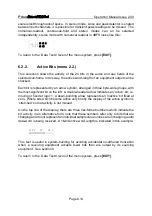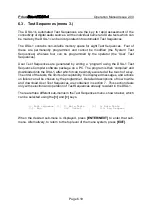
Prism
Operation Manual Issue 2.00
Page 6.28
6.4.2.
Edit Modes (menu 4.2.)
The functionality of the Edit Modes sub-menu is mainly restricted to GEN1 mode, as
selected in the Audio Function sub-menu, 4.3.
The display format is:
Editing [TIED]
Ù
Aud:Y C-S:Y V:Y
The flashing arrow symbol indicates which parameter is selected for adjustment, and
this selection is cycled using the [ENTER/NEXT] key. The [<] and [>] keys are used
to adjust the selected parameter by stepping through the available settings.
The TIED/SPLIT field determines whether all audio, Channel Status and Validity
settings which will be made in the other sub-menus will apply to both sub-frames
(channels), or just to the current sub-frame as set by the state of the [CHAN] key. The
SPLIT state allows the A and B channels to be set differently in any or all of these
parameters as desired. Note that switching between these two settings causes all sub-
frame A parameters to be copied to sub-frame B.
The remaining fields are used to globally enable editing for audio, Channel Status and
Validity data respectively. In DI Sync mode, switching any of these fields to 'N' disables
generation of the respective data (as controlled in the other sub-menus) and reverts to
passing through the DI data. In Internal or Ref sync modes, this simply has the effect
of globally 'blacking' the respective data.
These concepts are described in more detail at the start of section 6.4 and in figure 6.2.
The [EDIT/CLEAR] key can be used to select the default value of the currently-
selected parameter, which are TIED and all fields transparent.
When GEN2 is selected, edits are always TIED. When in 'in-line editing' mode, all field
edit selections are forced to 'N', otherwise all are forced to 'Y', as described at the
beginning of section 6.4. Since no adjustments are possible in GEN2 mode, the
flashing arrow is disabled.
To return to the `Generator' level of the menu system, press [EXIT].






























